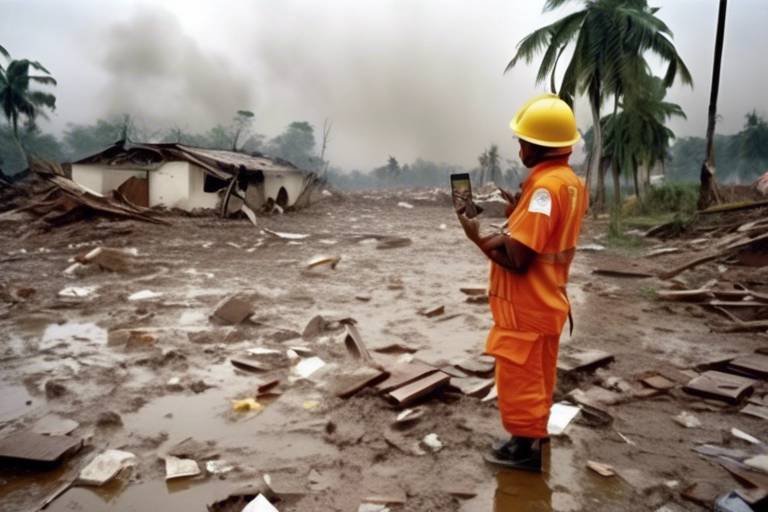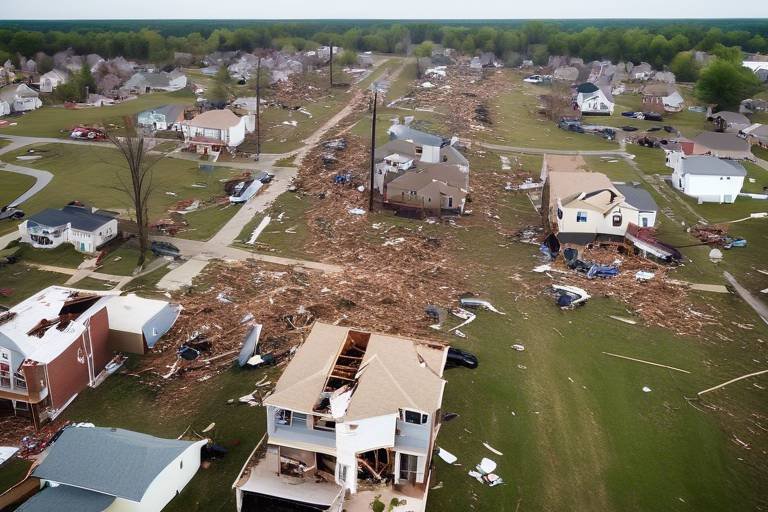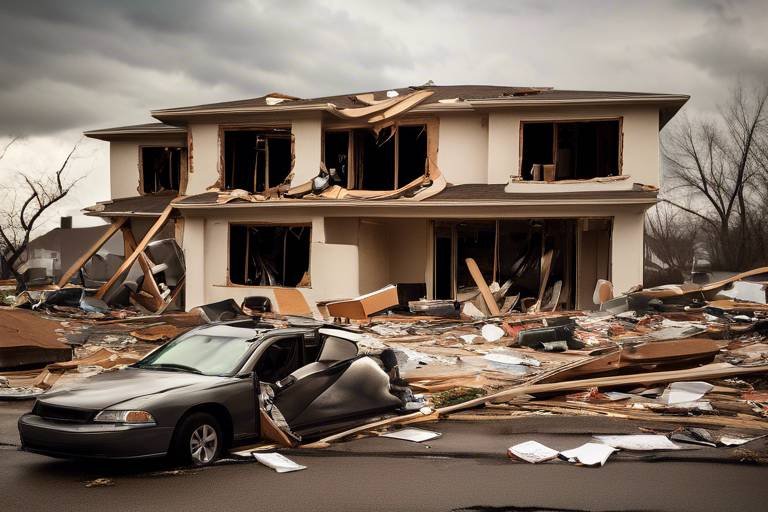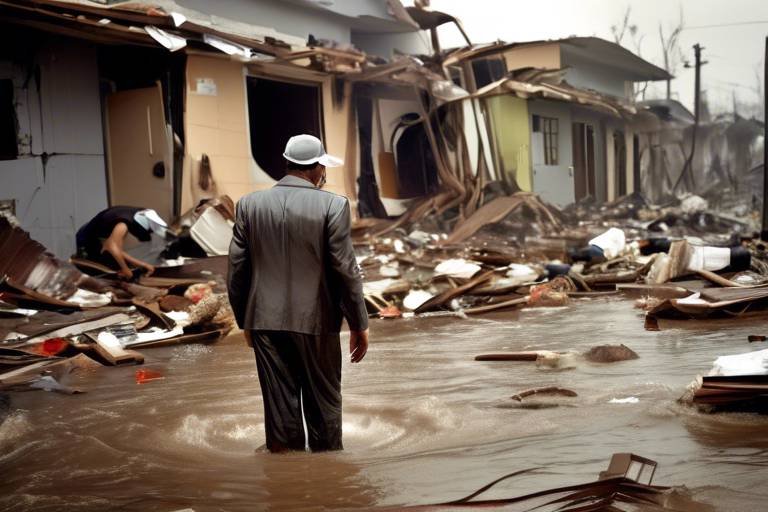The Importance of an Early Warning System in Disaster Management
In today's unpredictable world, the significance of an Early Warning System (EWS) in disaster management cannot be overstated. These systems act as the first line of defense against natural disasters, providing crucial information that can mean the difference between life and death. Imagine waking up to a serene morning, only to find out that a hurricane is barreling toward your community. Without an effective EWS, many might remain unaware of the impending danger, leading to chaos and devastation. However, with timely alerts and information, individuals and families can take proactive measures to protect themselves and their property.
Early Warning Systems are designed to monitor, detect, and disseminate information about potential hazards. They serve as a vital communication bridge between authorities and the public, ensuring that everyone is informed and prepared. The essence of these systems lies in their ability to provide timely and accurate information. This allows communities to act swiftly, whether it’s evacuating an area, securing homes, or implementing emergency plans. When we think about the countless lives that can be saved through effective early warnings, it becomes clear that investing in these systems is not just a necessity but a moral obligation.
One of the most compelling aspects of Early Warning Systems is their versatility. They can be tailored to address various types of disasters, including meteorological events like storms and floods, seismic activities like earthquakes, or even biological threats such as pandemics. Each system is designed with a specific focus, ensuring that the unique characteristics of different hazards are taken into account. For instance, a meteorological early warning system utilizes advanced technology to predict severe weather, while a seismic early warning system can provide alerts mere seconds before an earthquake strikes. This diversity means that communities can be better prepared for a wide range of emergencies.
Moreover, the implementation of these systems has shown to significantly enhance community resilience. When people are informed and prepared, they are more likely to respond effectively to disasters. This preparedness fosters a sense of security and confidence within communities, transforming them into proactive entities rather than reactive ones. The emotional and psychological benefits of knowing that a system is in place to warn about potential dangers cannot be underestimated. It empowers individuals to take ownership of their safety and the safety of their loved ones.
To fully appreciate the impact of Early Warning Systems, we must also consider their economic implications. The costs associated with disasters can be staggering, affecting not just individuals but entire communities and economies. By providing timely alerts, these systems can significantly reduce economic losses. For example, timely evacuations can prevent damage to property and infrastructure, while preemptive measures can mitigate the impact of disasters. It's not just about saving lives; it's about preserving livelihoods.
| Type of Early Warning System | Primary Focus | Example of Use |
|---|---|---|
| Meteorological | Weather-related disasters | Hurricane alerts |
| Seismic | Earthquakes | Earthquake early warnings |
| Flood | Flooding events | River flood alerts |
In conclusion, the importance of an Early Warning System in disaster management is profound. From saving lives to minimizing economic losses, these systems are invaluable in today’s world. They not only provide critical information but also foster a culture of preparedness and resilience within communities. As we continue to face the challenges of natural disasters, investing in and improving these systems should be a top priority for governments and organizations worldwide. After all, when it comes to safety, being prepared is always better than being caught off guard.
- What is an Early Warning System? An Early Warning System is a set of tools and processes designed to monitor potential hazards and provide timely alerts to communities.
- How do Early Warning Systems save lives? By providing timely information about impending disasters, these systems enable individuals to take protective actions, reducing the risk of injury or death.
- What types of disasters can Early Warning Systems address? Early Warning Systems can be tailored to various disasters, including meteorological events, earthquakes, floods, and biological threats.
- Why is community preparedness important? Community preparedness enhances resilience, allowing individuals and organizations to respond effectively to disasters, which ultimately saves lives and minimizes damage.

The Role of Early Warning Systems
Early warning systems are not just fancy gadgets or complex algorithms; they are the lifelines that connect communities to safety and preparedness. Imagine waking up to a sunny day, only to receive an alert that a tornado is heading your way. That’s the power of early warning systems—they transform fear into action, giving people the time they need to protect themselves and their loved ones. These systems are essential tools that provide timely information about potential disasters, enabling communities to prepare and respond effectively.
At their core, early warning systems function by monitoring environmental conditions and analyzing data to predict potential threats. They serve as the alarm bells that signal impending disasters, whether it's a hurricane brewing in the ocean or seismic activity indicating an earthquake. The information they provide can be the difference between life and death. For instance, when a tsunami warning is issued, the seconds saved can lead to thousands of lives being spared. This is why understanding their role is crucial; it significantly mitigates risks and enhances safety across the board.
To grasp the importance of these systems, consider the following elements that highlight their multifaceted role:
- Data Collection: Early warning systems gather data from various sources, including satellites, weather stations, and seismic sensors. This information is crucial for accurate predictions.
- Analysis and Prediction: Advanced algorithms process the collected data to forecast potential disasters, allowing authorities to issue timely alerts.
- Communication: Effective communication channels ensure that alerts reach the public quickly and efficiently, often through multiple platforms such as mobile apps, social media, and traditional media.
- Community Engagement: By involving local communities in the preparedness process, these systems foster a culture of resilience and readiness.
In essence, the role of early warning systems extends beyond mere alerts; they empower communities to take charge of their safety. When people are informed, they can make better decisions, whether it’s evacuating a dangerous area or securing their homes against potential damage. Furthermore, these systems are vital for coordinating responses among emergency services, government agencies, and community organizations, ensuring a unified approach to disaster management.
As technology continues to evolve, so too does the effectiveness of early warning systems. Innovations such as artificial intelligence and machine learning are enhancing predictive capabilities, making these systems even more reliable. The integration of social media platforms allows for real-time updates, ensuring that everyone remains informed, no matter where they are. Therefore, investing in and improving early warning systems is not just a smart move; it’s a necessity for safeguarding lives and property in an unpredictable world.

When it comes to disaster management, understanding the different types of early warning systems is crucial. Each system is designed to tackle specific risks and challenges posed by various disasters. By tailoring responses to the unique characteristics of each threat, these systems play a pivotal role in safeguarding communities. Let's dive into the major types of early warning systems that are making a difference in disaster preparedness and response.
One of the most prevalent types is the meteorological early warning system. This system focuses on weather-related disasters such as hurricanes, tornadoes, and severe storms. Utilizing cutting-edge technology, meteorological systems predict severe weather events by analyzing atmospheric data and patterns. With advancements like satellite imagery and predictive modeling, meteorologists can now provide timely alerts to communities at risk. This capability is not just about issuing warnings; it’s about creating a culture of preparedness where residents know what to do when severe weather strikes.
Next, we have seismic early warning systems, which are specifically designed to detect earthquakes. These systems can provide crucial alerts mere seconds before the shaking begins. While it may seem like a short time, those precious seconds can be the difference between life and death. People can take protective actions, such as dropping to the ground, covering their heads, or moving away from windows. The technology behind these systems involves a network of sensors that monitor seismic activity, allowing for rapid data transmission and alert generation.
Another significant type is the flood warning system. Floods can occur with little warning, making these systems essential for communities prone to such disasters. Flood warning systems utilize data from rainfall forecasts, river gauges, and weather patterns to predict flooding events. They often employ a combination of technology and community engagement, ensuring that alerts reach the public through various channels, including mobile notifications, sirens, and local media. By keeping communities informed, flood warning systems help residents take necessary precautions, such as evacuating to higher ground or securing their properties.
To give you a clearer picture, here's a
| Type of Early Warning System | Focus Area | Key Technology |
|---|---|---|
| Meteorological | Weather-related disasters (e.g., hurricanes, tornadoes) | Satellite imagery, predictive modeling |
| Seismic | Earthquakes | Seismic sensors, rapid data transmission |
| Flood | Flooding events | Rainfall forecasts, river gauges |
In summary, early warning systems are not one-size-fits-all solutions. Each type serves a vital role in addressing specific disaster scenarios, ensuring that communities can respond effectively to the challenges they face. By investing in these systems, we not only enhance our preparedness but also foster a culture of resilience that can withstand the test of time.
Q: How do early warning systems work?
A: Early warning systems work by collecting data from various sources, analyzing it, and disseminating alerts to the public via multiple channels to ensure timely responses to potential disasters.
Q: Can early warning systems prevent disasters?
A: While early warning systems cannot prevent disasters, they significantly mitigate their impact by providing communities with the information they need to prepare and respond effectively.
Q: What technologies are used in early warning systems?
A: Technologies used in early warning systems include satellite imagery, seismic sensors, rainfall forecasts, and advanced data analytics to predict and monitor potential disaster scenarios.

Meteorological early warning systems are critical components in safeguarding communities from the wrath of severe weather events. These systems are designed to provide timely and accurate information regarding potential weather-related disasters, such as hurricanes, tornadoes, and floods. By leveraging advanced technology, these systems can predict dangerous weather patterns and alert the public before disaster strikes, allowing individuals and communities to prepare and respond effectively.
Imagine waking up to a sunny morning, only to receive an alert that a severe storm is approaching your area. Thanks to meteorological early warning systems, you have the opportunity to gather your family, secure your property, and make informed decisions about evacuation if necessary. This proactive approach can mean the difference between life and death, as well as the preservation of property and resources.
The backbone of meteorological early warning systems is the use of cutting-edge technology. These systems utilize a variety of tools, including satellite imagery, Doppler radar, and predictive modeling. These technologies work in tandem to analyze weather patterns and predict severe conditions. For instance, satellite imagery can provide real-time data on cloud formations, while Doppler radar can detect precipitation and wind patterns. This data is then processed through predictive models that forecast the trajectory and intensity of storms.
Moreover, the dissemination of this information is just as crucial as its accuracy. Meteorological early warning systems utilize multiple channels to communicate alerts to the public, including:
- Television and radio broadcasts
- Mobile alerts and text messages
- Social media platforms
- Community sirens and public address systems
This multi-faceted approach ensures that the message reaches as many people as possible, regardless of their preferred mode of communication. The effectiveness of these systems is evident in their impact on community preparedness. When residents are informed about potential threats, they are more likely to take necessary precautions. This heightened awareness can lead to:
- Increased participation in community preparedness drills
- Better resource allocation for emergency services
- Stronger community bonds as neighbors work together to ensure safety
In conclusion, meteorological early warning systems play an invaluable role in disaster management. They not only provide critical information that can save lives but also foster a culture of preparedness within communities. As technology continues to evolve, we can expect these systems to become even more sophisticated, ultimately enhancing our ability to predict and respond to severe weather events.
1. How do meteorological early warning systems work?
Meteorological early warning systems use advanced technologies like satellite imagery and Doppler radar to monitor and predict severe weather conditions. They analyze data to forecast storms and disseminate alerts through various communication channels.
2. What types of disasters can these systems help prevent?
These systems primarily focus on weather-related disasters, including hurricanes, tornadoes, floods, and severe thunderstorms. Their timely alerts can help communities prepare and respond effectively to these threats.
3. How can I receive alerts from meteorological early warning systems?
You can receive alerts through multiple channels, including television and radio broadcasts, mobile alerts, social media notifications, and community sirens. It's important to stay connected to these sources, especially during severe weather seasons.
4. Are there any limitations to meteorological early warning systems?
While these systems have significantly improved in accuracy and timeliness, they may still face challenges such as unpredictable weather patterns and technological limitations in remote areas. Continuous advancements in technology aim to address these issues.

In the realm of meteorology, technological advances have revolutionized how we predict and respond to severe weather events. Gone are the days when forecasts were based solely on observations and historical data. Today, we harness the power of cutting-edge technologies that provide us with real-time data, significantly enhancing our ability to foresee and react to impending disasters.
One of the most impactful advancements is the use of satellite imagery. Satellites orbiting the Earth capture detailed images of weather patterns, allowing meteorologists to monitor changes in the atmosphere with unprecedented accuracy. This technology enables the detection of developing storms, tracking their paths, and predicting their intensity. For instance, during hurricane season, satellites can provide crucial information about the storm's development, helping communities prepare for potential landfall.
Moreover, predictive modeling has become a game-changer in weather forecasting. Utilizing complex algorithms and vast amounts of data, meteorologists can simulate various weather scenarios. These models take into account numerous variables, such as temperature, humidity, and wind patterns, to generate forecasts that are not only timely but also highly accurate. This predictive capability is essential for issuing early warnings, allowing people to take proactive measures.
Additionally, advancements in data analytics and cloud computing have made it possible to process and analyze meteorological data at lightning speed. This means that alerts can be generated and disseminated almost instantaneously, reaching communities before disaster strikes. For example, when a tornado is detected, the system can quickly analyze the data and send alerts via multiple channels—text messages, social media, and local news broadcasts—ensuring that everyone is informed.
The integration of mobile technology also plays a significant role in enhancing early warning systems. With the majority of people owning smartphones, meteorological agencies can leverage mobile apps to push notifications directly to users. These apps provide real-time updates about severe weather, safety tips, and evacuation routes, making it easier for individuals to stay informed and act swiftly.
To sum up, the technological advances in meteorology have not only improved the accuracy of weather predictions but have also transformed how we communicate these warnings to the public. By utilizing satellite imagery, predictive modeling, data analytics, and mobile technology, we can significantly enhance our preparedness for severe weather events, ultimately saving lives and reducing damage.
- What are the key technologies used in meteorological early warning systems?
Key technologies include satellite imagery, predictive modeling, data analytics, and mobile applications that help disseminate information quickly and effectively. - How do early warning systems save lives?
They provide timely alerts that allow individuals and communities to take protective actions, such as evacuations, thereby minimizing casualties during disasters. - Can early warning systems help reduce economic losses?
Yes, by enabling timely evacuations and minimizing damage through preemptive measures, early warning systems can significantly decrease economic losses during disasters.

When it comes to disaster management, the impact of early warning systems on community preparedness cannot be overstated. Imagine living in a town where residents receive timely alerts about impending disasters—this is not just a dream; it’s a reality made possible by effective early warning systems. These systems equip communities with the necessary information to respond swiftly and efficiently to potential threats. When people are informed about a looming disaster, they can take proactive measures, such as securing their homes, gathering essential supplies, and formulating evacuation plans. This proactive approach can mean the difference between life and death.
Moreover, early warning systems foster a culture of preparedness within communities. They encourage individuals to stay informed and engaged with local emergency management efforts. Communities that prioritize disaster preparedness often conduct regular drills and training sessions to ensure that everyone knows what to do when an alert is issued. This not only enhances individual readiness but also strengthens community bonds as residents work together to protect one another. The sense of unity and shared responsibility can be incredibly empowering, transforming a potentially chaotic situation into a well-orchestrated response.
Additionally, the effectiveness of these systems is amplified when they are integrated into local education programs. Schools can play a pivotal role by incorporating disaster preparedness into their curricula. This could involve teaching students about the types of disasters that might affect their region, how to respond to alerts, and the importance of having an emergency kit at home. When children are educated about disaster preparedness, they become advocates for safety within their families and communities, creating a ripple effect of awareness and readiness.
In conclusion, the impact of early warning systems on community preparedness is profound. They not only provide crucial information but also foster a culture of readiness and resilience. By investing in these systems and integrating them into community education, we can empower individuals and families to face disasters head-on, ultimately saving lives and minimizing damage.
- What is an early warning system?
An early warning system is a set of tools and processes designed to provide timely information about potential disasters, enabling communities to prepare and respond effectively.
- How do early warning systems save lives?
By providing timely alerts about impending disasters, early warning systems allow individuals to take necessary precautions, such as evacuating or securing their homes, thus saving lives.
- What types of disasters can be predicted with early warning systems?
Early warning systems can predict various disasters, including meteorological events like hurricanes and tornadoes, seismic events like earthquakes, and floods.
- How can communities improve their preparedness?
Communities can improve their preparedness by investing in early warning systems, conducting regular drills, and integrating disaster preparedness education into schools and community programs.

Seismic early warning systems are revolutionary technologies that play a pivotal role in mitigating the impact of earthquakes. Imagine feeling a gentle tremor beneath your feet, only to realize that a significant earthquake is about to strike. This is where seismic early warning systems come into play, providing crucial seconds of advance notice that can be the difference between life and death. These systems utilize a network of seismic sensors to detect the initial, less damaging waves of an earthquake, known as P-waves, which travel faster than the more destructive S-waves. When a seismic event is detected, alerts are rapidly disseminated to individuals, businesses, and emergency services, giving them precious moments to take protective actions.
The technology behind seismic early warning systems is impressive. It involves a combination of ground sensors, data processing algorithms, and communication networks that work together to assess the magnitude and location of an earthquake. The system can predict the shaking intensity at various locations, allowing for tailored alerts. For instance, if an earthquake is detected off the coast, people in coastal areas can receive warnings a few seconds before the shaking reaches them. This lead time, although it may seem short, can be crucial for implementing safety measures.
Moreover, the implementation of seismic early warning systems has been shown to significantly reduce injuries and fatalities during earthquakes. For example, in Japan, the country's advanced warning system has saved countless lives by alerting people seconds before shaking begins. During the 2011 Tōhoku earthquake, the system provided warnings that allowed many individuals to take cover, and trains to slow down or stop, preventing accidents and injuries. This real-world application underscores the importance of investing in such technologies.
While the benefits of seismic early warning systems are clear, it's essential to recognize that public education and preparedness are equally important. Communities must be informed about how to respond to alerts effectively. This can include:
- Practicing drop, cover, and hold on drills.
- Creating emergency plans and communication strategies.
- Ensuring that buildings comply with seismic safety standards.
In summary, seismic early warning systems are a critical component of disaster management strategies. They not only provide life-saving alerts but also enhance community resilience by fostering a culture of preparedness. As technology continues to advance, the potential for these systems to save lives and reduce damage during seismic events will only grow stronger.
Q: How do seismic early warning systems work?
A: Seismic early warning systems work by detecting the initial seismic waves of an earthquake using a network of ground sensors. They analyze the data in real-time and send alerts to individuals and organizations seconds before the more damaging waves arrive.
Q: How much warning time can these systems provide?
A: The warning time can vary depending on the distance from the earthquake's epicenter. In some cases, people can receive alerts anywhere from a few seconds to a couple of minutes before the shaking begins.
Q: Are seismic early warning systems effective?
A: Yes, seismic early warning systems have proven effective in reducing injuries and fatalities during earthquakes. Countries like Japan and Mexico have successfully implemented these systems, demonstrating their life-saving potential.
Q: What should I do when I receive a warning alert?
A: When you receive a warning alert, it's crucial to take immediate protective actions, such as dropping to the ground, taking cover under sturdy furniture, and holding on until the shaking stops.

Implementing early warning systems offers a plethora of benefits, transforming the way communities prepare for and respond to disasters. One of the most significant advantages is the potential for reduced casualties. When individuals are alerted to impending threats, they have the opportunity to take protective actions, whether that means evacuating their homes or seeking shelter. This proactive approach can mean the difference between life and death in critical situations.
Moreover, early warning systems play a crucial role in minimizing economic losses. By providing timely information, these systems enable communities to execute timely evacuations and implement preemptive measures that mitigate damage. For instance, consider the economic impact of a hurricane: with an effective early warning system, residents can secure their properties and businesses, thus reducing potential financial losses. A recent study indicated that for every dollar invested in early warning systems, communities can save up to $7 in disaster response costs. This statistic underscores the financial viability of such systems, highlighting their importance not just for safety but also for economic stability.
In addition to saving lives and reducing costs, early warning systems enhance community resilience. They foster a culture of preparedness and awareness, empowering individuals and organizations to respond effectively to emergencies. When communities are well-informed and trained to act, they can recover more quickly from disasters, leading to a stronger societal fabric. For example, communities that regularly participate in disaster drills and training sessions are often better equipped to handle actual emergencies. The sense of unity and shared responsibility that emerges from these activities can significantly bolster community ties.
Furthermore, the integration of technology in early warning systems has revolutionized the way we approach disaster management. With advancements such as real-time data analytics and mobile alert systems, information can be disseminated rapidly and efficiently. This technological edge ensures that alerts reach even the most remote areas, ensuring that no one is left unprepared. The ability to communicate effectively during a crisis is paramount, and early warning systems are at the forefront of this communication revolution.
In summary, the benefits of early warning systems are multifaceted, ranging from saving lives and reducing economic losses to enhancing community resilience. As we continue to face an increase in natural disasters, investing in these systems is not just a wise decision; it’s a necessary step towards ensuring the safety and well-being of our communities.
- What is an early warning system? An early warning system is a set of processes and technologies designed to provide timely information about potential disasters, allowing communities to prepare and respond effectively.
- How do early warning systems save lives? By alerting individuals to impending threats, early warning systems give people the time they need to take protective actions, such as evacuating or seeking shelter.
- What types of disasters can early warning systems address? Early warning systems can be tailored to address various disasters, including meteorological events (like hurricanes), seismic events (like earthquakes), and flooding.
- Are early warning systems cost-effective? Yes, studies have shown that for every dollar spent on early warning systems, communities can save significantly more in disaster response costs.

The economic impact of early warning systems (EWS) cannot be overstated. These systems serve as a crucial line of defense against the financial repercussions of disasters. By providing timely alerts, EWS enables communities to implement preventive measures that can significantly minimize damage and associated costs. For instance, when a severe weather event, such as a hurricane or flood, is anticipated, early warnings allow for swift evacuations, securing of property, and mobilization of emergency services. This proactive approach not only saves lives but also protects valuable assets.
Consider this: the cost of implementing an early warning system is often a fraction of the potential losses incurred during a disaster. According to studies, every dollar invested in early warning systems can save up to $7 in disaster recovery costs. This impressive return on investment highlights the importance of integrating EWS into disaster management strategies. Furthermore, the economic benefits extend beyond immediate savings; they foster a sense of security that encourages local businesses and communities to invest in their future.
To illustrate the economic advantages of early warning systems, let’s look at a comparative analysis of regions with and without effective EWS in place. The following table summarizes key findings:
| Region | With EWS | Without EWS |
|---|---|---|
| Average Economic Loss (per disaster) | $1 million | $5 million |
| Evacuations Implemented | 95% | 30% |
| Community Recovery Time | 6 months | 2 years |
This table clearly shows that regions equipped with early warning systems experience significantly lower economic losses and recover more quickly from disasters. The statistics speak volumes: when communities are informed and prepared, they can avoid the devastating financial impacts that often follow natural calamities.
Moreover, the economic impact of early warning systems extends to insurance and government funding. Insurers are more likely to offer favorable rates to communities that have robust EWS in place, recognizing that these systems reduce the likelihood of catastrophic losses. Additionally, governments can allocate resources more effectively, focusing on recovery and rebuilding rather than emergency response, which can lead to a more resilient economy overall.
In conclusion, the economic impact of early warning systems is profound. By investing in these systems, communities not only protect lives but also safeguard their economic future. It's a win-win scenario that underscores the necessity of prioritizing early warning systems in disaster management strategies. After all, when it comes to disaster preparedness, the real cost of inaction can be staggering.
- What are early warning systems? Early warning systems are tools that provide timely information about potential disasters, enabling communities to prepare and respond effectively.
- How do early warning systems save lives? By alerting communities to imminent threats, individuals can take protective actions, such as evacuating or securing their properties.
- What is the economic benefit of early warning systems? Early warning systems can save significant amounts of money by reducing disaster-related losses and recovery times.
- Are early warning systems worth the investment? Yes, studies show that for every dollar spent on early warning systems, communities can save multiple dollars in disaster recovery costs.

When we talk about community resilience, we're really diving into how well a community can bounce back from disasters. Think of it like a rubber band: the more flexible and strong it is, the better it can handle being stretched without breaking. Early warning systems play a crucial role in this resilience by providing communities with the information they need to prepare for potential disasters. By keeping people informed, these systems foster a culture of readiness and awareness that can make all the difference when disaster strikes.
Imagine a community that has been hit by a severe storm. With an effective early warning system in place, residents receive timely alerts about the incoming weather. This means they can secure their homes, gather necessary supplies, and even evacuate if needed. The result? Fewer injuries, less property damage, and a community that feels empowered rather than helpless in the face of adversity. It’s this empowerment that builds resilience.
Moreover, early warning systems encourage collaboration among various stakeholders, including local governments, emergency services, and community organizations. When everyone is on the same page, the response to a disaster can be much more coordinated and effective. For example, schools can implement safety drills, businesses can develop contingency plans, and families can create emergency kits. This collective preparation not only enhances individual safety but also strengthens the entire community's ability to respond to crises.
In addition, early warning systems can help in educating the public about the specific risks they face. By understanding the types of disasters that are most likely to occur in their area, residents can take proactive measures to protect themselves and their property. For instance, those living in flood-prone areas might learn the importance of elevating their homes or creating barriers to divert water. This knowledge transforms fear into action, further enhancing resilience.
In summary, enhancing community resilience through early warning systems is not just about saving lives during a disaster; it’s about building a culture of preparedness that empowers individuals and communities alike. The more prepared a community is, the more resilient it becomes, creating a cycle of safety and strength that can withstand even the most challenging situations.
- What is an early warning system? An early warning system is a set of tools and procedures that provide timely information about potential disasters to help communities prepare and respond effectively.
- How do early warning systems save lives? By providing alerts and information, early warning systems allow individuals to take protective actions before disasters occur, thereby reducing casualties.
- What types of disasters can early warning systems address? Early warning systems can address a variety of disasters, including meteorological events (like hurricanes), seismic events (like earthquakes), and floods.
- How can communities improve their resilience? Communities can improve resilience by investing in early warning systems, conducting regular drills, and fostering a culture of preparedness and awareness.
Frequently Asked Questions
- What is an early warning system?
An early warning system is a set of tools and processes designed to provide timely information about potential disasters. This allows communities to prepare and respond effectively, ultimately saving lives and reducing damage.
- How do early warning systems work?
These systems use various technologies, such as meteorological data, seismic sensors, and flood monitoring, to detect early signs of disasters. Once a threat is identified, alerts are disseminated to the public through various channels, ensuring that people have the information they need to take action.
- What types of disasters can early warning systems address?
Early warning systems can address a wide range of disasters, including weather-related events like hurricanes and tornadoes, seismic events like earthquakes, and hydrological events such as floods. Each system is tailored to the specific risks associated with these events.
- Why are meteorological early warning systems important?
Meteorological early warning systems are crucial because they provide forecasts and alerts about severe weather. This information helps communities prepare for potential impacts, allowing them to take protective measures to safeguard lives and property.
- How do seismic early warning systems save lives?
Seismic early warning systems detect the initial seismic waves of an earthquake and send alerts seconds before the more damaging waves arrive. This brief lead time can enable people to take cover, stop hazardous activities, and evacuate if necessary, significantly reducing injuries and fatalities.
- What are the economic benefits of early warning systems?
Implementing early warning systems can lead to substantial economic benefits by minimizing damage and losses during disasters. Timely evacuations and preventive measures can save communities millions in recovery costs, making these systems a wise investment.
- How can communities enhance their resilience using early warning systems?
Communities can enhance their resilience by fostering a culture of preparedness and awareness through early warning systems. By educating residents about potential risks and encouraging proactive measures, communities can respond more effectively to disasters and recover more quickly.


















